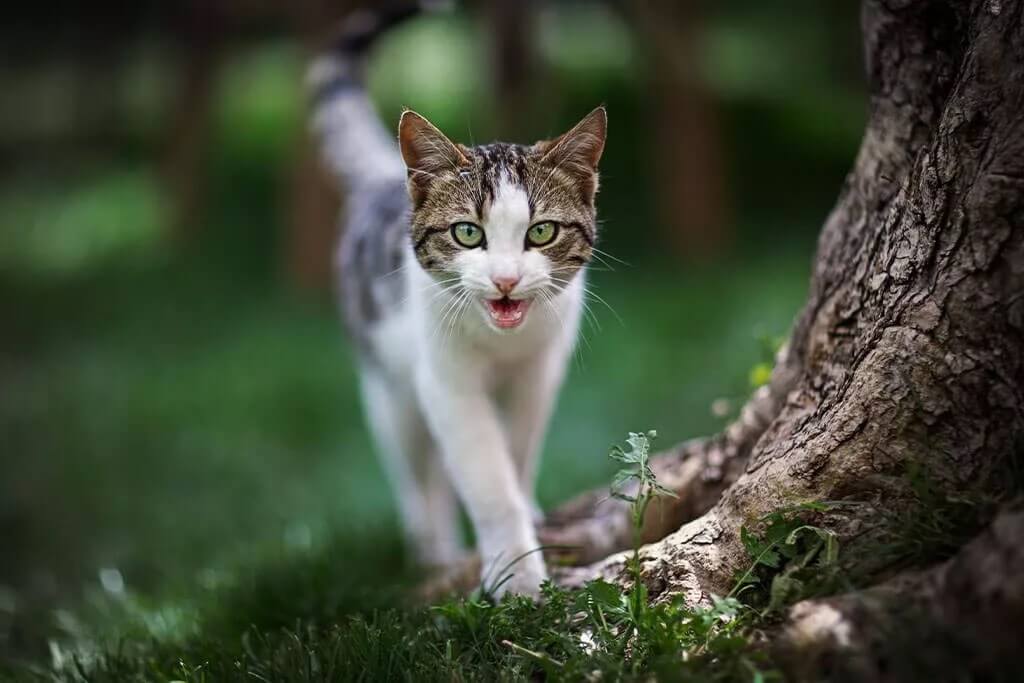Why Does My Cat Lift Their Paw? A Guide to Cat Body Language
Of course, context matters when discussing body language and meaning. Our cat friends are funny little creatures who are hard to understand. Instead of speaking our language, cats, like ourselves, use their bodies to communicate with others. We can tell what our cat buddies tell us and feel through their tails, ears, body, and eyes.

5 Common Cat Sounds
Listed below are five of the most common cat sounds and more information about what they could mean about your furry friend.
Meowing
We have all heard cats meowing before. This is the most common sound that cats make, although some cats are quieter than others. When your cat meows, it could be for many reasons. Although there are many reasons that it could be, cats usually make this sound when they want attention.
First, take a look around you. Is there something your cat is currently circling and meowing at? Ask yourself, what is your cat looking at? If they are looking at you, it is likely that they want your attention for something.
Cats are smart creatures and know that if they want to get their way, it is important to be as loud as possible. Without this sound, we would have no idea what their needs or wants are! Meowing is adorable and innocent and can either be low or high pitched. Truly, there is no one right way a cat should meow.
Chirping
Did you know that some cats can chirp? Yes, you read that right. Some cats chirp like a bird, either out of excitement or frustration. The louder a cat is, the more emotion they are feeling to chirp loudly. It is a high-pitched sound and occurs over and over again.
This sound is especially common in cats that are needy and like attention. Have you come home, and your cat is chirping at you? This is likely to let you know that they have missed you! Sometimes, they also make this same sound though when they are hunting and feel the excitement.
Hissing
Cats not only speak out when they need something, like food or water, but also when they are warning someone or something. It is common to hear a cat hiss and scrunch their face in an aggressive way towards something that scares them or that they do not like.
Instead of attacking right away, cats that feel threatened are protecting something while making an airy hiss in the direction of the threat. It is best to leave your cat alone if they are hissing at you or something around them. Be aware before they pounce!
Purring
When cats purr, their chests and bodies vibrate deeply. It not only sounds gentle, but also looks adorable. Most of the time, cats will purr and coo at their owners and loved ones when they feel loved or want attention.
Usually, though, purring is followed by a body action. For example, your cat may be purring while rubbing your face or your feet. This is to tell you that they feel good and affectionate. Some cats, though, will also purr when they are upset and frustrated. The best way to make the distinction is to look at how they move their tails.
Chattering
Did you know some cats can chatter almost as if they are smacking their teeth and talking to friends? Chattering is another sound often made when their emotions are high! It is a high-pitched rumble. Not all cats, though, make this same sound as adorable as it is.
Body Language to Consider
Noise is only one way that cats communicate with each other and their humans. Most of the time, cats and humans rely on watching each other’s body language to understand meanings. Cats will often move their tails in certain ways, widen their eyes, and flex their fur.
Something to note is that cats usually react with their bodies when they are feeling angry, stressed, or upset. It is likely that their fur will stand up when they are nervous or ready to attack. Usually, tails tucked into their bodies also means that the cat is feeling stressed.
The Sounds Cats Make Can Mean Many of Things
All in all, cats are very vocal animals that want to express their emotions in their own way. Most of the time, it is through commonly heard sounds like meowing, chirping, chattering, and more. Not only do they use these sounds to communicate with their owners and loved ones, but their body language also changes.
It is important for cat owners to monitor their cat’s body language as well as vocal ranges since the same movements and sounds can mean various different messages. It is up to us as loving cat owners to understand what our furry friends are saying.
Tail
One of the most common signs of body language we see in cats is lifting their tail. Some cats lift their tails high or low, depending on their exact emotion.
High-Tail
When our feline companions are walking around with a high tail, this could mean many things. When the tail is high, this can let us know, their owners and family, that they are feeling confident and happy. When their tails are held high, they are almost showing off.
However, there is also a double meaning to this. When their tails are high, they can also be ready to attack something either playfully or aggressively. This truly depends on the situation. If your cat is watching something, like a bug, they are most likely about to pounce when their tails shoot up nice and tall.
Swishing or Low Tail
Another common tail sign is a tail that is either swishing or low. This usually never indicates something positive in cats. If you notice your cat is swishing their tail, it means that they are irritated or anxious. Something around them is stressing them out.
To calm down your cat that is reacting to stress by swishing its tail, it is essential to provide them with a safe space they can run to. This can be under a couch, in a separate room, or in a corner that is away from others. Cats are good at calming themselves down, but it is important to know when they are feeling nervous.
Ears
Not only do tails allow us to figure out what cats are telling us, but so do their ears. Cat ears are typically triangle-shaped and pointed up but move constantly depending on their mood.
Forward and Tall
When cats have their ears pointed forward and tall, this is a good sign. Their pointed ears indicate that they are calm, happy, and enjoying themselves. During this sign, they are typically alerted to something going on around them. Most of the time, they raise their ears when playing or enjoying their rest.
Flat Down Ears
Ears that are flat and facing downward can indicate that there is something wrong. When the ears are flat, the cat is typically outwardly expressing that they are angry or scared. The distinction between both of these emotions, of course, first comes from context.
For example, if your cat has been playing with another cat and the cat is being rough, their ears may lay flat in anger as a warning that they will attack if the other cat does not stop. The ears can be a warning or a sign that they are nervous. Some cats, for instance, fear loud noises, and their ears will automatically lay flat with rolling thunder.
Body
Posture is everything for cats. The way they stand and the direction they face can tell us a lot about what they are feeling and what they need from us.
Normal Posture Facing Forward
When your cat is engaging in a normal posture, this typically means that they are feeling relaxed and filled with content. A normal posture is exhibited when cats are not feeling tense. They are sitting and are faced forward to their owner or pet friend.
This can also indicate that they want attention. Their body posture is calm, open, and facing towards the person, they want affection from. Be sure to give your cat lots of extra cuddles, love, and hugs when they are positioned faced forward.
Crouched-Low Posture
When you see a cat that is crouched and has a low posture, this can mean one of two things; they are afraid, or they are in hunt mode. Cats crouch and try to stay away from things that they are fearful of. Some things they may be afraid of include:
- Spraying Water
- Loud Noises
- Bright Flashing Lights
Once the stressor is taken away, their posture is sure to change and straighten out. Fear is not the only message being crouching, however. When cats crouch, they can also be getting ready to pounce and hunt down their prey. Cats are great at catching bugs and will not hesitate at jumping and capturing them in your home.
Eyes
The eyes truly are the window to the soul, and this is very true about cats. Our feline friends have great vision and large eyes with clear pupils. Small changes in pupil shape can tell us what they want.
Unblinking Stare
Sometimes cats will begin a staring competition with their owners. This cute and hilarious motion is a message to their owners that they are trying to establish dominance and control. They may lash out and attack to gain control. Unblinking stares in a cat look like large eyes with slits for pupils.
Large Pupils
When you see large pupils in a cat, they are either active and alert or full of trust. When your cat’s eyes are large, they are attentive and looking for something. This could be a fly buzzing around the home or their toy that they accidentally flung across the room and misplaced.
Also, they may be a sign that they trust you. Large pupils tell us that the cat is aware of you and is open to you.
You Now Know the Basics of Cat Body Language
All in all, it is important to understand the basics of the cat language. While cats can be vocal, using meows and purrs to communicate, their body language can tell us more. Creatively cats use their eyes, ears, body, and tail to send warnings and messages to their owners and other animals. These messages can be both positive and negative, depending completely on the context.
Share This Article
About
Schertz Animal Hospital
Since 1976, Schertz Animal Hospital has offered the greater San Antonio area outstanding pet care. Our state-of-the-art animal hospital in Schertz, TX compliments our stress-free handling and experienced veterinary staff. Make an appointment online or give us a call at (210) 659-0345 today!
